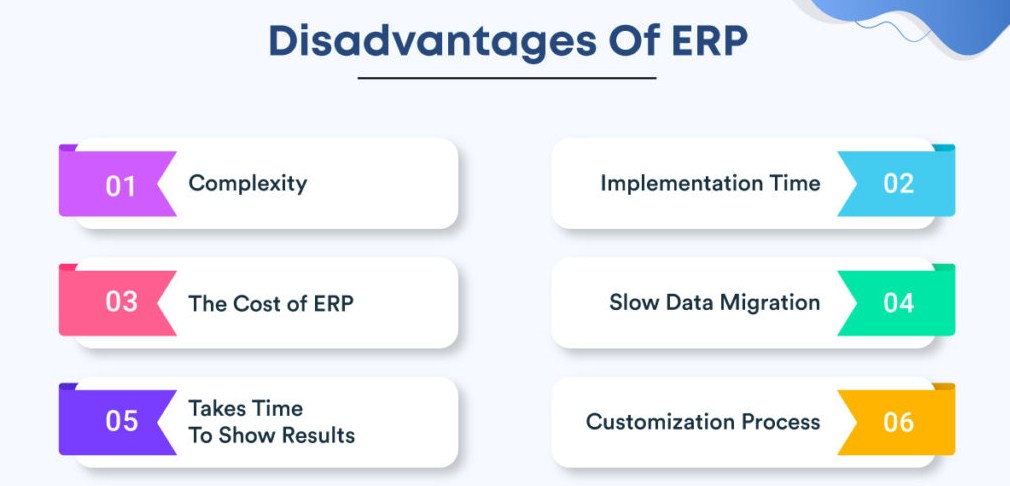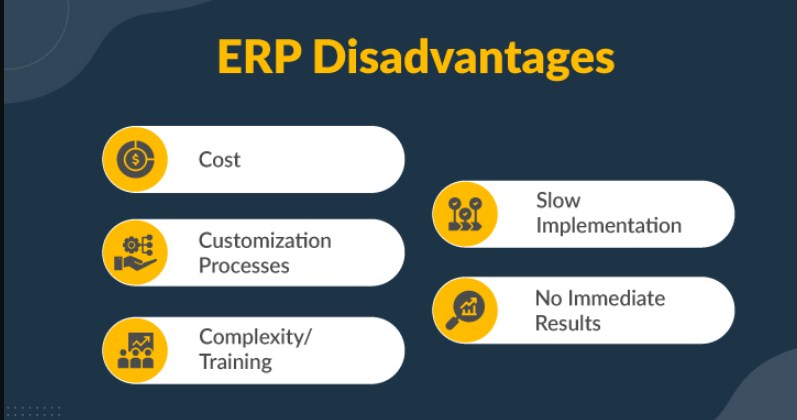The Disadvantages of ERP Systems – In today’s fast-paced business environment, many companies are implementing Enterprise Resource Planning (ERP) systems to streamline their operations and improve efficiency. ERP systems combine various business processes into a single unified system, offering significant benefits. However, there are certain ERP disadvantages that businesses should consider before making the leap.

In this article, we will dive deep into the potential drawbacks of ERP systems. Whether you’re contemplating an ERP solution for your business or trying to optimize your existing system, understanding these disadvantages is crucial for making an informed decision. Let’s explore the downsides of ERP systems, provide detailed examples of products related to ERP, and discuss how to make the best choice for your business. 😕
ERP Disadvantages: A Closer Look
1. High Implementation Costs
One of the most significant disadvantages of ERP systems is the high initial cost. Not only do you have to pay for the software itself, but also for the implementation, training, and integration with your existing infrastructure. The total cost of ownership can easily spiral out of control if the project isn’t managed well.
Detailed Breakdown of Costs:
- Software Licensing Fees: ERP software can range from a few thousand dollars to millions, depending on the size of your company.
- Customization and Integration Fees: Tailoring the ERP system to your specific business processes can be expensive.
- Training Costs: Ensuring your employees are fully trained on the new system adds to the cost.
Example Product:
- SAP ERP is a leading ERP system used by large enterprises. It offers robust features but comes at a significant cost, especially for small businesses.
2. Complex Implementation Process
ERP implementation is often a complex and lengthy process. It requires significant time and effort to integrate the system into all areas of the business, and if not done correctly, it can disrupt your business operations.
Challenges in Implementation:
- Data Migration: Moving data from old systems to the ERP system can be time-consuming and prone to errors.
- Customizations: Tailoring the ERP system to your business’s unique needs requires expertise and time.
- Employee Training: Employees must undergo extensive training, which can lead to productivity losses during the transition period.
Real-World Example:
- Oracle ERP Cloud offers a comprehensive cloud solution for large enterprises but can require significant time for deployment due to its complexity.
3. Scalability Issues
ERP systems, particularly older or less flexible ones, may not be scalable enough to accommodate the future growth of your business. As your company expands, you may find the ERP system unable to handle the increased data load or the evolving needs of your business.
Example Products:
- Microsoft Dynamics 365 is known for its scalability, but smaller businesses may find it overwhelming due to its complexity.
4. Risk of Over-automation ⚙️
While automation is one of the key advantages of ERP systems, over-automation can lead to the loss of the human touch. Some critical decisions may require human input, and excessive automation could reduce flexibility in responding to customer needs.
Example Product:
- Infor CloudSuite automates many business processes but can create rigidity in business workflows if not properly managed.
5. Change Management Challenges
When introducing an ERP system, companies often face resistance to change from employees who are accustomed to older systems. Managing this change is critical to the success of the ERP implementation. Employees may feel overwhelmed by the new technology or fear job displacement.
Benefits of ERP Systems: Why They Are Still Worth Considering
Despite the disadvantages, ERP systems offer significant benefits that can outweigh the cons. Let’s look at some of the key benefits:

1. Centralized Data Management
An ERP system centralizes all your business data into a single, unified system. This ensures that all departments have access to accurate and up-to-date information, which can significantly improve decision-making and efficiency.
Benefit Example:
- If you’re in manufacturing, an ERP system can provide real-time inventory data, which helps optimize your production process.
2. Improved Reporting & Analytics
ERP systems come with built-in reporting and analytics tools that allow businesses to analyze data across departments. This can help you identify trends, predict future demands, and make data-driven decisions.
Benefit Example:
- A company can track sales performance and make adjustments to marketing strategies using data pulled directly from the ERP system.
3. Streamlined Operations
By automating business processes, an ERP system can streamline your operations, saving time and reducing errors. Whether it’s finance, HR, or supply chain management, ERP helps simplify tasks that would otherwise require manual effort.
Comparison of ERP Products
| Product Name | Use Case | Pros | Cons | Price Range | Features |
|---|---|---|---|---|---|
| SAP ERP | Large enterprises | Scalable, robust, customizable | High cost, complex deployment | Custom pricing | Financial management, supply chain, HRM |
| Oracle ERP Cloud | Medium to large businesses | Cloud-based, easy updates | Expensive, requires training | Contact for pricing | Financials, procurement, project management |
| Microsoft Dynamics 365 | Small to large enterprises | Integrated with other Microsoft tools | High learning curve | $40 – $200 per user/month | Sales, customer service, finance, operations |
| Infor CloudSuite | Manufacturing and distribution | Highly customizable, industry-specific | Requires heavy customization | Contact for pricing | Supply chain, production, finance, HR |
| NetSuite ERP | Growing businesses | Cloud-based, scalable | Expensive, requires expertise | $99 – $500 per user/month | Financial management, order processing, inventory |
Where to Buy ERP Systems and How to Get Started
Buying an ERP system requires careful consideration and research to ensure you select the right product for your business needs. Here’s how to buy and get started:
- Research: Begin by researching ERP providers and their offerings. Take the time to understand which features are most important for your business.
- Request a Demo: Most ERP vendors offer free demos so you can test out the system before making a purchase.
- Pricing and Contracts: Ask for a clear breakdown of pricing. ERP systems usually come with yearly contracts, so make sure to clarify all costs involved.
How Much Do ERP Systems Cost?
ERP pricing can vary dramatically based on the features, customization, and scale of deployment. Generally, expect to pay anywhere from $5,000 to $500,000 for an ERP system. Smaller businesses may pay on the lower end, while larger enterprises may pay much more.
Contact SAP
Contact Oracle
Get Started with Microsoft Dynamics 365
FAQs
1. What are the main disadvantages of ERP systems?
The main disadvantages include high initial costs, complex implementation processes, scalability issues, and potential resistance to change from employees.
2. Are ERP systems worth the investment?
Yes, despite their disadvantages, ERP systems offer numerous benefits such as streamlined operations, centralized data, and improved reporting, which can make them highly valuable for businesses.
3. How long does it take to implement an ERP system?
The implementation timeline depends on the size and complexity of your business. It can take anywhere from 3 months to over a year to fully implement an ERP system.
4. Which ERP system is best for small businesses?
For small businesses, Microsoft Dynamics 365 or NetSuite ERP may be more suitable due to their scalability and cloud-based solutions.
5. How much do ERP systems cost?
ERP system costs can range from $5,000 to $500,000 depending on the features and size of the company. Monthly subscription fees typically range from $40 to $500 per user.
This article provides an in-depth look into ERP disadvantages, while also highlighting some ERP solutions, their features, and where to buy them.
Read More >>>
- The Ultimate Guide to Astral Manufacturing ERP: Features, Benefits, and How to Buy
- Best SaaS ERP for Small Business in 2025 | Improve Efficiency & Save Time